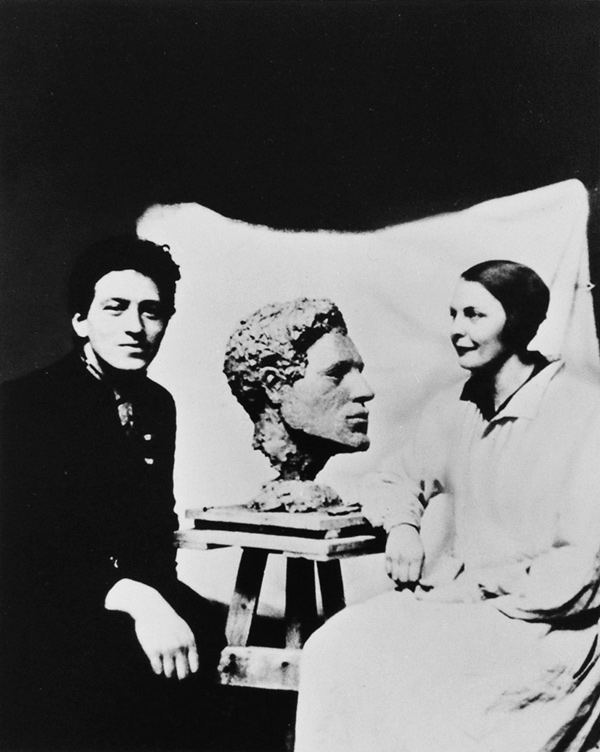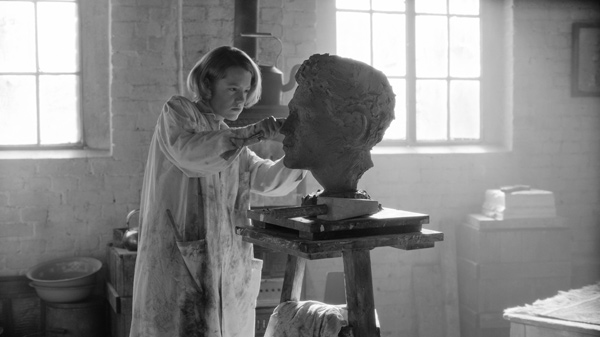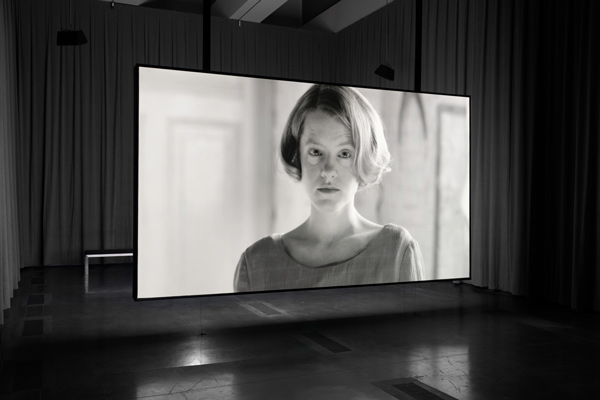Flora, Teresa Hubbard / Alexander Birchler’s enticing and enigmatic, double-sided film installation premiered at the 2017 Venice Biennale (in the Swiss Pavilion) and is currently on view at The Los Angeles County Museum of Art (through April 7). In this presentation, a single large-scale screen is suspended in the center of the darkened gallery. First viewers encounter documentary footage of an elderly man, David Mayo (81 at the time of the filming), reminiscing about his mother. On the other side of the screen, a narrative filmed in black and white recreates aspects of a 1933 relationship between Alberto Giacometti and the young Flora Mayo, David’s mother.

Teresa Hubbard / Alexander Birchler, Flora, 2017, synchronized double-sided film installation with shared soundtrack, 30 min, loop. Installation detail, Los Angeles County Museum of Art, promised gift of Suzanne Deal Booth, © Teresa Hubbard / Alexander Birchler, photo © Museum Associates/LACMA
The impetus for Flora came from the artists’ research on Giacometti. In James Lord’s biography they happened upon a photograph of Giacometti and Mayo sitting with a bust—the only surviving documentation of her art. Curious about Mayo, they followed numerous trails that ended with the discovery that she had a son living in California. The meeting between the artists and Flora’s son led to a sharing of not only his memories of his mother’s life, but letters, photographs and notes which became the basis of the film—and a glimpse into Flora’s life while she was involved with Giacometti.

Teresa Hubbard / Alexander Birchler, Bust, 2017, Flora Mayo and Alberto Giacometti, with the bust she made of him, circa 1927. Photographer unknown. Original photograph belonging to Flora Mayo, kept under her mattress, lost. Film negative missing. Reproduction from only known duplicate print, archive of Fotostiftung Schweiz, Winterthur. Original clay bust portrait of Alberto Giacometti by Flora Mayo, lost. Reconstructed and cast in brass. Framed silver gelatin print, 34 5/8 x 28 3/8 in, Brass sculpture with concrete base, 60 5/8 x 18 7/8 x 21 in. Installation detail, Los Angeles County Museum of Art, gift of the Artists and Lora Reynolds Gallery, © Teresa Hubbard / Alexander Birchler, photo © Museum Associates/LACMA
By watching both sides of the screen, we learn that Flora Mayo went to Paris in 1925 leaving behind a husband and child to become an artist. She studied to be a sculptor and there met Giacometti and they later became lovers. During the depression, her stipend was rescinded and she was forced to return to the United States after destroying all the art she created. Through voice over, her son David relates his mothers struggles as a single woman (his father is never revealed), holding menial jobs to support her family. David was not aware of his mother’s affair with Giacometti, nor did he know much about the artist’s work until his wife Googled “Flora Mayo.” Toward the end of the film, audiences watch the unpacking of Giacometti ‘s 1926 sculpture Flora and David’s first encounter with this work, as he emotionally declares: “This is my mother.”

Teresa Hubbard / Alexander Birchler, Flora, 2017, synchronized double-sided film installation with shared soundtrack, 30 min, loop. Installation detail, Los Angeles County Museum of Art, promised gift of Suzanne Deal Booth, © Teresa Hubbard / Alexander Birchler, photo © Museum Associates/LACMA
The two films share a single soundtrack that weaves between Hubbard and Birchler’s interview with David, and Flora’s voice-over, compiled by the artists to accompany the acted recreation. Flora poses many questions about art and the desire to be an artist, and themes of discovery, love and unfulfilled dreams. The parameters of the times—and Flora’s dependence on her family’s money for survival—kept her from staying in Paris and becoming an artist. Destroying her work effectively silenced that aspect of her life. That David never knew this side of his mother’s history is tragic. In Flora, Hubbard and Birchler present a fragment of these two artists’ lives, one renowned, the other anonymous, juxtaposing the subtle black and white footage with the harsher reality of David trying to piece together what might have been.
Teresa Hubbard / Alexander Birchler, Flora, January 20 – April 7, 2019, Los Angeles County Museum of Art, 5905 Wilshire Boulevard, Los Angeles CA 90036. www.lacma.org


